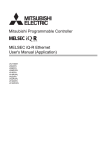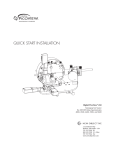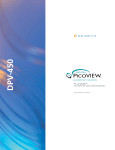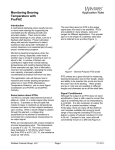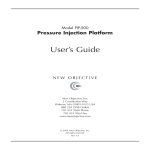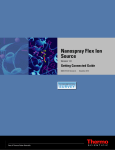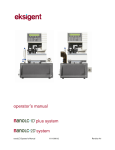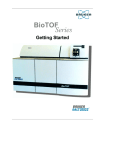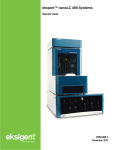Download Tip Adapters - New Objective, Inc.
Transcript
PicoTip Adapter ® Models ADPT-TLC ADPT-TLC ADPT-TLD ADPT-MZS Instruction Manual New Objective, Inc. 2 Constitution Way Woburn, MA 01801-1023 USA 888 220 2998 Orders 781 933 9560 Phone 781 933 9564 Fax www.newobjective.com © 2004 New Objective, Inc. All rights reserved. Rev 2.0 PicoTip ® Adapter Instruction Manual N E W O B J E C T I V E Contents 1 Read This First • 1 1.1 Safety Considerations • 1 1.1.1 Prior to Installation • 1 1.1.2 Handling Fused-Silica Tubing • 1 1.1.3 Tip Adjustment and/or Replacement • 1 1.1.4 The Transfer Line • 2 2 Product Overview • 3 2.1 System Components • 3 2.2 Modes of Electrical Contact • 4 3 Installation of ADPT-TLC & ADPT-TLD • 5 For Thermo Finnigan TSQ®, LCQ™ Classic & Duo 3.1 Installation Into ESI Manifold • 5 3.2 TSQ® & LCQ™ Special Considerations • 7 3.2.1 Model ADPT-TLC for API-1 • 7 3.2.2 ADPT-TLD for the API-2 Source • 8 3.3 Determination of Maximum Probe Extension by Indirect Measurement • 8 3.4 Determination of Maximum Probe Extension by Direct Measurement • 8 3.5 Fitting the Adapter with 1/16” OD Tubing (For API-1 Sources Only) • 9 4 Installation of ADPT-PRO • 10 For Protana ES023 Nanospray Source 4.1 Mounting on the Protana Nanospray Stage • 10 5 Installation of ADPT-MZS • 12 For Micromass ZSpray™ Source 6 Preparation and Mounting of PicoTips® • 13 6.1 Tip and Sleeve Preparation • 13 6.2 Mounting on the Instrument • 14 i PicoTip ® Adapter Instruction Manual 7 Performance Tips • 16 7.1 Ready for Use • 16 7.2 Choosing a PicoTip® Size • 16 7.3 Achieving Good Coupling • 16 7.4 In-line Filtration • 16 7.5 Operating Parameters • 16 7.5.1 Tip-to-Inlet Distance • 16 7.5.2 Applied Voltage • 17 7.5.3 Flow Rate • 17 7.6 Voltage/Flow Rate Interdependence • 17 7.7 Voltage Tuning Procedure • 17 7.8 Voltage Tuning with Distal Coated TaperTips™ • 18 7.9 Elastomer Replacement • 18 8 Limited Warranty and Disclaimer • 19 ii N E W 1 O B J E C T I V E Read This First 1.1 Safety Considerations WARNING: Electrospray ionization involves the use of potentially lethal high-voltage electrical current. Observe all manufacturers’ safety recommendations in the use of such equipment. No equipment modifications should be made except by trained personnel using methods approved by the manufacturer in accordance with all safety requirements. Installation of equipment should be performed by qualified personnel in accordance with all applicable electrical codes. Never use this product with defective, damaged, or faulty equipment. Serious injury or death could result. SAFETY PRECAUTIONS: Only qualified personnel should use this product. Provide a safe workplace equipped with all necessary safety equipment. 1.1.1 Prior to Installation Follow all safety recommendations of the equipment manufacturer(s). All system voltages must be brought to ground potential and all high-voltage contacts disconnected from the inlet system before installation of the PicoView™ system. Inspect all equipment carefully prior to use. Any damaged, chipped, or cracked components should not be used and must be discarded or repaired. 1.1.2 Handling Fused-Silica Tubing Handling of fused-silica or glass tubing and tips can result in serious personal injury, including eye and skin injury. Use safety glasses or goggles meeting ANSI Z87.1-1989 requirements, or the equivalent. Puncture- and chemical-resistant gloves should also be worn at all times. 1.1.3 Tip Adjustment and/or Replacement Do not attempt to adjust or replace the tip unless the ESI high voltage and other applicable voltages are turned off and are at ground potential. WARNING: Reduce any applicable backing pressure (liquid, gas, etc.) to ambient before loosening ESI tip fittings and removing the fused-silica tip or transfer line from the coupling union. Prior to pressurization, make sure that components are tightened to specifications to prevent separation during use. Failure to adhere to this warning could result in projectile-like expulsion of the tip from the coupling union, which could cause serious personal injury or damage to surrounding apparatus. 1 PicoTip ® Adapter Instruction Manual 1.1.4 The Transfer Line WARNING: The transfer line connecting to the tip adapter must not be made from an electrically conductive material. It must be fabricated from an electrically insulating material such as PEEK™ or fused silica. Otherwise, the operator may be exposed to potentially lethal voltage. In systems where high voltage is applied directly to the ESI tip, the liquid sample inside the tip and transfer line tubing is also raised to a high voltage. To prevent exposure to potentially lethal voltages, a suitable ground point for the liquid inside the line must be provided. Consult your source manufacturer’s guide for a suitable grounding point. NOTICE: User is solely responsible for complying with any patent(s) pertaining to the application of these products. 2 N E W 2 O B J E C T I V E Product Overview Your new PicoTip® adapter, model ADPT-TLC, ADPT-TLD, ADPT-PRO, or ADPT-MZS provides an efficient solution for implementing low-flow rate electrospray ionization (ESI) using fused-silica emitters with your mass spectrometer. The ADPT-TLC and ADPT-TLD are designed to replace the conventional ESI needle assembly on selected instruments (LCQ™, TSQ®) from Thermo. The ADPT-PRO replaces the standard ESI source head on the nano-electrospray retrofit system from Protana (now Proxeon). The ADPT-MZS is a ZSpray™ modified version of the ADPT-PRO model for use on Micromass® (a division of Waters) ZSpray sources. All models are designed around Upchurch Scientific’s® advanced line of Microtight™ HPLC fittings. These fittings, designed specifically for the efficient coupling of fused silica tubing, offer the highest possible coupling efficiency in a system of 100% PEEK™ construction. Adapter Model For System... Adapter Type ADPT-TLC Thermo Finnigan LCQ™ Classic Thermo Finnigan SSQ/TSQ® API-1 (T-rail) Source PicoTip® ADPT-TLD Thermo Finnigan LCQ™ Duo, Deca (off-axis) Source Thermo Finnigan SSQ/TSQ® API-2 (swing-out) Source PicoTip® ADPT-PRO Protana NanoES Stage PE Biosystems Mariner™ with nano-LINK™ PicoTip® ADPT-MZS Micromass® ZSpray™ NanoFlow™ PicoTip® By combining your PicoTip adapter with an appropriately sized PicoTip, you can perform electrospray at flow rates well below 1 µl/min while maintaining the versatility of on-line methods. The addition of a syringe pump and injection valve, autosampler, or capillary chromatography system, enables you to enjoy the convenience of conventional ESI with the full efficiency of flow rates normally associated with nano-electrospray methods. New Objective manufactures PicoTips in a variety of tubing sizes with tip diameters to support flow rates from less than 10 nL/min to over 500 nL/min. Operation at these low flow rates does not require the use of sheath or make-up liquids, thus maintaining maximum analytical sensitivity. Your adapter kit was shipped with a variety of fused-silica PicoTips, with tip sizes from 5 to 15 µm and two different styles of conductive coatings. For more information on tip selection please consult your PicoTip product literature, visit our web site at www. newobjective.com or call New Objective toll free at (888) 220-2998. 2.1 System Components ADPT-TLC and ADPT-PRO models come with two different Microtight™ fittings: a silica-silica zero dead volume union and a zero-dead volume silica-to-1/16” OD tubing adapter. These components utilize precision ID PEEK™ sleeves to accommodate different OD’s of fused-silica tubing. Sleeves for 150 and 360 µm OD tubing are supplied. The core components of the ADPT-TLC are interchangeable with those of the ADPT-PRO. If you have purchased the ADPT-TLC and you also have a Protana NanoES system, you have the choice of using your adapter directly on the LCQ/TSQ ESI assembly or the core components on the Protana X, Y, Z stage. 3 PicoTip ® Adapter Instruction Manual 2.2 Modes of Electrical Contact When combined with New Objective’s variety of PicoTip® coating options, your PicoTip adapter becomes a versatile system capable of a variety of ESI modes. The conventional PicoTip multi-layer coating (catalog notation -CE-), covers the tip-end of the ESI emitter and is used to establish electrical contact with the analyte at the tip (Figure 2 top). The PicoTip distal coating (catalog notation -D-) covers the back end of the emitter, leaving the tip uncoated and providing an electrical contact with the analyte in the liquid junction within the coupling union (Figure 2 bottom). The distal coating enables liquid contact without possible contamination from exposing analyte and solvents to materials like stainless steel or graphite. Union FingerTight™ fitting PEEK™ sleeve Spring contact Proximal tip coating Distal tip coating Coating in union (enlarged for detail) Figure 2: Proximal and Distal Coatings In both cases, electrical contact is established through the spring contact mechanism contacting the conductive coating. New Objective also offers the option of using titanium unions to establish liquid contact for the elimination of coatings altogether. Please contact us for details. Please note that the titanium option is not available for thr ADPT-PRO. WARNING: The transfer line connecting with the union must not be made from an electrically conductive material. It must be fabricated from an electrically insulating material such as PEEK™ or fused-silica. Otherwise you risk exposure to high voltage. The interior of the ESI Probe assembly is held at the ESI high voltage. The use of an electrically conductive transfer tubing or column would expose the exterior of the instrument and the surrounding environment to this hazard. 4 N E W 3 O B J E C T I V E Installation of ADPT-TLC & ADPT-TLD For Thermo Finnigan TSQ®, LCQ™ Classic, Duo & Deca 3.1 Installation Into ESI Manifold Installation of the ADPT-TLC or ADPT-TLD involves the replacement of the Finnigan ESI nozzle and tip assembly. Depending on your model of ESI source, exact details of this substitution may differ. Please use these directions as a basic guide. Contact New Objective with any questions you may have regarding the substitution. To install the mounting adapter (refer to Figures 7 & 8 on page 6), three components must be removed from the ESI probe; the ESI nozzle cone, the stainless steel needle, and the needle seat. Union adapter Spring contact PicoTip® PEEK™ union Transfer line Figure 2: ADPT-TLC / ADPT-TLD Spray manifold 1/16” HPLC fitting Electrically insulated transfer line PicoTip™ adapter mount 1/16” OD SealTight™ sleeve End of transfer line Figure 3: Cross-section of ESI manifold after conversion with ADPT-TLC / ADPT-TLD 1. Set your system to standby and reduce the ESI potentials to zero. 2. On the LCQ™, slide the ESI probe assembly back on its guide rails. On the older model TSQ®, back off the probe assembly on the T-rail support far enough to provide sufficient workspace. On newer model TSQs, swing the probe assembly out into the open position. Remove the flange from the the instrument if additional working space is required. 3. Place a vent cap over the inlet capillary to protect the MS inlet. 4. Remove the high-voltage connection, sheath gas line, auxillary gas line, sheath liquid line, and sample liquid line from the rear of the ground shield if connected. 5. Remove the ESI spray nozzle (stainless steel part with the cone end protruding from the ESI assembly) from the ESI probe by turning the flats conter-clockwise until it is free of the spray manifold. Carefully remove the nozzle by pulling it forward to prevent bending the ESI needle. Make sure that all O-rings are removed with the nozzle. 6. Remove the needle and needle T seat from the manifold. (These are two separate components.) The needle seat is conveniently removed with a gentle puff of compressed gas applied to the sample inlet. 7. Making sure the 1/4” ID O-ring is in place on the body of the adapter LTQ001 (see Figure 7), screw the adapter into place. Part LTQ002, for model ADPT-TLD, does not require an O-ring. (The leaf spring contact washer of the API-2, Duo and Deca sources, should remain in place.) There is 5 PicoTip ® Adapter Instruction Figure 4: ADPT-TLC side view Manual Figure 5: ADPT-TLC front view Spring assembly Do not feed tip throught his hole in the elastomer! Conductive elastomer Groove for PicoTip® Groove alignment adjustment screw Set screw for jumper wire MicroTight fitting screw Jumper wire Figure 6: Detail of spring mount clamp Figure 7: LTQ001 Figure 9: ADPT-TLC installed on an LCQ™ Classic 6 Figure 8: LTQ002 Figure 10: ADPT-TLD installed on an off-axis ThermoQuest ESI probe N E W 8. 9. 10. 11. O B J E C T I V E no need to use a wrench. Hand-tight is sufficient. Do not overtighten the adapter or you may damage the ESI manifold threads or manifold sleeve. If you are using fused-silica tubing to connect the PicoTip® adapter, you should first thread the tubing through an appropriately sized 1/16” OD SealTight™ sleeve and 10-32 HPLC fingertight fitting. This provides protection against damage to the silica tubing. Feed the tubing through the ESI manifold and the through-hole in the PicoTip adapter. Screw the 10-32 fitting into the sample port. Do not fully tighten to allow for sliding of the silica tubing (Figure 3). Reconnect the sheath gas to the manifold. Auxiliary gas and sheath liquid connections will not be necessary for low-flow rate operation. Although sheath gas is not required for stable ESI at low flow rates, sheath gas pressure is required to satisfy the software interlock system controlling high voltage. DO NOT reconnect the High Voltage at this point. If gas consumption is too high, we recommend the installation of a suitable needle valve to reduce flow while maintaining back pressure. Your mount is now ready for installation of a the assembled union and spring clamp adapter to carry out the alignment procedure in the next section. 3.2 LCQ™ & TSQ® Special Considerations ADPT-TLC or ADPT-TLD adapters are held within the conventional Finnigan ESI probe. Thus the PicoTip is not visible during operation. This places a principal length constraint when mounting a PicoTip. It is possible to mount a PicoTip too far out where there is a chance the PicoTip could hit the inlet capillary when the ESI probe assembly is slid into position. Such action would destroy the PicoTip and could damage, or even clog the inlet capillary. Small particles of silica could also enter the vacuum system causing further harm and contamination. We recommend following the described procedures before a tip is installed or any change is made in the configuration of the system. 3.2.1 Model ADPT-TLC for API-1 The Thermo Finnigan ESI (API-1) probe is composed of the outer ESI flange and the inner ESI probe assembly manifold. The system offers considerable variation in needle-to-inlet distance by varying the distance the probe protrudes from the flange. In the original version of the source, the ESI manifold is held in place with a set screw and O-ring arrangement. Proper care must be taken to ensure the two system components are in identical registration each time the unit is setup. In Figure 11 on page 8, the probe protrusion distance, A, is easily changed while the inlet depression distance B, is fixed. The second generation ESI source offers even greater adjustment range of tip to inlet distance. To minimize variability we strongly recommend mounting components in a manner that yields the maximum distance from tip to inlet (minimizing distance A). The principle characteristic to look for is full extension of the ESI probe assembly within the ESI flange; it should be as far back as possible. It is important that distance A is the same each time the adapter is assembled. 7 PicoTip ® Adapter Instruction Manual 3.2.2 ADPT-TLD for the API-2 Source ESI probe assembly ESI flange ESI nozzle Inlet The API-2 has a refined manifold that provides a greater range of motion combined with improved positioning repeatability. Suitable results may be obtained with the probe located in the number 2 or 3 position. Position 2 is the preferred setting. 3.3 Determination of Maximum Probe Extension by Indirect Measurement The ADPT-TLD has been designed so when assembled with the PEEK™ union, the total (minimum) length is approximately 35 mm long from end-to-end. With the 1/16”-to-silica adapter in place the total (minimum) length is 38 mm. This length is close to (within 1-2 mm) that of the conventional nozzle. It is important that the union assembly is fully inserted into the LTQ™ adapter for reproducible results. O-rings Figure 11: Adjustment of API-1 source When you mount a PicoTip®, the distance it protrudes from the mount brings it that distance closer to the inlet. With the ADPT-TLD mounted on your system, we recommend using a ruler or caliper to measure distances A and B to calculate the distance between the nozzle and inlet on your instrument. With the API-1 source it is likely that the distance D (D = B – A) will be on the order of 15 to 17 mm. The API-2 source will have a similar relationship when set in the number 2 position. This distance D is 1 mm more than the maximum distance a PicoTip should protrude from the mount. 3.4 Determination of Maximum Probe Extension by Direct Measurement The preferred method for determining maximum probe extension is by direct measurement. This method is far more accurate than the above method: 1. Mount the LTQ assembly on the probe according to the directions in section 4, omitting the addition of the transfer line. 2. Place a vent or protective cap over the inlet. If none are available, tear a 1 cm square corner from the sticky end of a 3M Post-it® note and place it over the end of the capillary inlet. Do not substitute adhesive tape as it may deteriorate the capillary surface. 3. Prepare the PicoTip mount as described in steps (1) through (4) of section 6, but substitute a 60-70 mm length of 360 um OD fused silica tubing for the 50 mm long PicoTip. 4. Screw the spring mount and MicroTight™ fitting into place but do not tighten. It is important the fused silica slide freely within the mount. (Do not place the gauge plug on the other side of the union.) 5. Slide the Delrin® collar holding the union with spring mount fully into the LTQ and tighten the set screw. 6. Make certain the fused silica extends at least 35 mm from the end of the mount. 7. Slide the ESI probe and flange into the operating position and tighten the flange mounting screw. Doing so will push the silica flush with the covered capillary inlet, provided that the silica can slide freely in and out. 8 N E W O B J E C T I V E 8. Retract the probe and flange assembly, and without disturbing its position, measure the full extension, D, of the silica tubing. 9. The maximum distance that a PicoTip™ should protrude from the mount is 1 to 2 mm less than the measured distance D. It is good practice to have at least 2 mm between the end of the probe and the capillary inlet. This will prevent damage to the PicoTip and will also serve to minimize potential problems with the probe’s axial alignment. NOTE: Any change in the setup, such as switching from the silica-silica union to the 1/16” adapter, will require repeating this procedure. 3.5 Fitting the Adapter with 1/16” OD Tubing (For API-1 Classic Sources Only) Although principally designed for use with fused-silica tubing your ADPT-TLC can accommodate 1/16” OD tubing. That is, you can directly couple a PicoTip with 1/16” OD tubing by substituting the 1/16” adapter for the fused-silica union. To do so you must make a minor modification to the ESI probe assembly. Specifically you need to remove the HPLC fitting inside the probe so 1/16” tubing can be fed directly through to the adapter. This will require disassembly of the ESI probe. Please consult your user manual. If you do plan to use 1/16” OD tubing it must be fabricated from an electrically insulating, nonconductive material such as PEEK™. Stainless steel, or other metal tubing, can not be used. To do so would result in exposure to potentially lethal high voltage. Fused-silica lined PEEK™, called PEEKsil™, should not be used in this application since most formulations contain an aluminum inner layer that would short out the HV source. NOTE: The through hole in the ESI probe is only 0.063”. Measure the OD of the plastic tubing you plan to use with a micrometer. It must be 0.061” in diameter or less to be suitable. 9 PicoTip 4 ® Adapter Instruction Manual Installation of ADPT-PRO For Protana ES023 Nanospray Source 4.1 Mounting on the Protana Nanospray Stage NOTE: Remove the glass nanospray tip before attempting removal of the banana plug from the source head. Installation of the ADPT-PRO adapter is straight-forward, involving the substitution of the conventional Protana source head with the PicoTip® adapter assembly. 1. Turn off all applicable ESI voltages and disconnect the high-voltage feed to the X,Y,Z stage. if possible (consult your system’s operator manual). Disconnect the high-voltage from the ESI tip or head. 2. Adjust the Z translation to pull the stage back to provide optimal working area. 3. Reduce any back pressure in the source head to ambient and disconnect the gas line. 4. Remove the source head by loosening the set screw holding it in place. 5. Remove the set screw from the Protana source head and screw it into the body of the ADPT-PRO (see Figure 12) 6. Using an adjustable wrench, remove the banana plug from the Protana source head and install it into the underside of the ADPT-PRO spring clamp assembly (Figures 13-16). Set screw Banana plug Figure 12: Transfer the set screw from the source head to the white, plastic body of the ADPT-PRO Figure 13: Use an adjustable wrench to unscrew the banana plug from the source head. Figure 14: The banana plug removed Figure 16: The ADPT-PRO adapter with transferred banana plug Figure 17: The ADPT-PRO installed on the Protana E023 source Tapped hole Figure 15: Install the banana plug into the tapped hole on the underside of the spring clamp assembly. 10 N E W O B J E C T I V E 7. Prepare the union or adapter for use (refer to Section 5: Preparing and Mounting of PicoTips® on page 13). 8. Insert the prepared union into the mount and tighten the set screw. Connect the high-voltage line to the banana plug (see Figure 17). 9. Position the tip in front of the inlet for ESI operation. 11 PicoTip 5 ® Adapter Instruction Manual Installation of ADPT-MZS For Micromass ZSpray™ ESI Source The ADPT-MZS is a ZSpray™ modified version of the ADPT-PRO Protana adapter. CAUTION: Before making this modification, ensure that all high voltages are off. Please consult your instrument’s safety documentation before making any modifications or adjustments to your ESI source. It is highly recommended that personnel properly trained in electrical wiring make jumper wire modifications. 1. Remove the Micromass mounting block by loosening the thumbscrew located on the underside of the plastic plate that protrudes from the top of the X,Y stage. 2. Place the ZNSMB-1 block on top of the L-shaped stage mount.Tighten the thumbscrew to lock it in place. The high voltage is conducted through the stage mount to the block. 2. Slide the white adapter body into the stainless mounting block and, using an Allen wrench, tighten the set screw on top of the block to hold the adapter in place. You will be able to adjust the course position of the PicoTip® by sliding the adapter in and out of the mounting block. 3. Connect the jumper wire between the spring clamp of the adapter and the base of the mounting block (see Figure 19). Connect one end of the jumper wire into the hole in the base of the adapter. Lock it into placeby tightening the set screw. 4. The other end of the jumper should connect to the mounting block assembly. The set screw on the side of the mounting block is used to lock the end of the jumper wire in place. 12 jumper wire set screw Figure 19: ADPT-MZS mounted on base N E W 6 O B J E C T I V E Preparation and Mounting of PicoTips® Although there are a few differences between the installation of tips on the ADPT-TLC/ADPT-TLD vs. the ADPTPRO. The following description focuses on the ADPT-TLC/ADPT-TLD. Generally the it is much easier to mount a tip for the ADPT-PRO on a Protana or Micromass translation stage, given the large adjustment range and direct tip view. Review documentation sent with PicoTips® prior to tip mounting. TSQ® and LCQ™ users using the ADPT-TLC/ADPT-TLD are strongly advised to follow the special procedure in Section 3 “Installation of ADPT-TLC and ADPT-TLD” on page 5 to avoid potential damage to their inlet system and the accidental damage to PicoTips. 6.1 Tip and Sleeve Preparation 1. Select the proper 0.025” OD PEEK™ tubing sleeves to match the OD of your PicoTip and transfer line (Figure 20). Cut a 14 mm length sleeve. Blue = 0.007” ID = 280 µm (Upchurch F183) Figure 20 Figure 21 Distal end of tip should protrude past the sleeve Figure 22 Green = 0.015” ID = 380 µm (Upchurch F185) Supplied PicoTips are 360 µm OD. 2. Trim the PicoTip sleeve to 13-14 mm with a sharp utility knife. Use a sharp blade to reduce the risk of collapsing or kinking the sleeve (Figure 20). 3. Insert a PicoTip inside the sleeve. The tip should have a free fit. (Figure 21) 4. Insert the sleeve and PicoTip into the MicroTight™ fitting mounted previously onto the spring contact device. Make certain the sleeve protrudes approximately 2 mm from the end of the fitting. 5. Carefully lift the spring clamp up and over the PicoTip, taking care not to damage the tip (see Figure 22). The screw protruding from the top of the clamp should insert into the mating hole in the base. The tip will be between the conductive elastomer and the base of the spring clamp. (See Figure 6 on page 6) 6. Trim the 5 cm PicoTip length (Figure 22). Use a high quality cleaving tool to minimize shattering of the tubing. A total PicoTip length of 27 mm should yield acceptable results. The PicoTip will protrude from the mount approximately 9 mm. Duo, Deca, and API-2 source users should refer to Section 3: Installation of the ADPT-TLC/ADPTTLD. Users with the Protana source do not need a critical length since the Z adjustment on the stage will accommodate different tip lengths. The distal 13 PicoTip 7. 8. 9. 10. ® Adapter Instruction Manual end of the fused-silica should protrude slightly (approximately 2 mm) beyond the sleeve ensuring even positioning of the silica and sleeve within the union. Finger-tighten the white gauge plug into one side of the union or 1/16” adapter (see Figure 23). Screw the assembled MicroTight™ fitting with clamping mechanism into the 6-32 end of the adapter, making sure that the tubing and sleeve are flush against the gauge plug. Do not over tighten (Figure 23). Remove the gauge plug. Into the other end of the fitting, insert the transfer line with appropriate sleeve and fitting Figure 24). The sleeve and fitting had been previously threaded through the ESI manifold on the ADPT-TLC/ADPT-TLD. Push the tubing flush with the distal end of the PicoTip® and tighten both fittings. You should now have a zero-dead volume connection. Over tightening can both damage the silica tubing and prevent the fittings from being reused. When properly fitted removal of the fitting would reveal the PicoTip to be flush with the PEEK™ sleeve. Both the PicoTip and sleeve should protrude from the end of the fitting (Figure 25). 6.2 Mounting on the Instrument 1. You are now ready to mount the tip assembly on the instrument. On the LCQ™ & TSQ®, push the assembly as far into the mounting adapter as possible and tighten set screw. If the tip protrudes too far from the mount, it may contact the capillary inlet. This situation will damage the tip and possibly the inlet. On the Protana, simply slide the assembly into the mounting hole and tighten the set screw. 2. Connect the transfer line to a source of liquid and pressurize the system as required (syringe pump at 100 nl/min etc.). After the line is primed, you should see a droplet of liquid at the end of the PicoTip. Inspect the union for any leaks etc., and tighten if necessary. 3. For LCQ/TSQ only – Remove the vent cap and slide the ESI probe to its forward limit. Pull it back and inspect the tip. If it is not broken or chipped, then you are a safe distance from the capillary inlet. Provided that all of the components are 14 Figure 23 Figure 24 Distal end of tip should be flush with the sleeve Figure 25 N E W O B J E C T I V E mounted flush to create the maximum distance between the probe assembly and the capillary inlet there is little danger of contact with a properly mounted tip. Under these conditions, tip to inlet distance should be on the order of 4-5 mm. 4. Connect the high-voltage lead: ADPT-TLC/ADPT-TLD - Connect the high voltage jumper wire from the screw on the faceplate of the mounting adapter to the hole in the base of the spring clamp assembly. Tighten the set screw. Reconnect the high-voltage line to the rear of the ESI probe assembly. PRO-ADP – Clip the red high-voltage lead to set screw (See Figure 6 on page 6). 5. Make certain the tip rests under the elastomer and sits within the centering groove. (See Figure 26) Screw is a guide pin. Do not attempt to adjust. Tip is between the elastomer and the groove PicoTip® Tip should be centered in the groove for optimal electrical contact Jumper wire Clamp Open Clamp Closed Figure 26: The spring clamp assembly uses a section of conductive elastomer in its upper section to provide a low resistance electrical contact. The elastomer completely eliminates the need for messy conductive paints. The lower section features a precision groove into which the PicoTip® sits for improved contact and positioning stability. When properly assembled, the PicoTip should sit in the groove with the elastomer holding it in place. The PicoTip should not be inserted through the hole in the elastomer. The hole simply provides the elastomer with flexibility. 15 PicoTip 7 ® Adapter Instruction Manual Performance Tips 7.1 Ready for Use A tip is mounted in the system a safe distance from the inlet, fluid transfer has been established, and electrical contact has been made. Your PicoTip® adapter is now ready for use. Once all system safety shields are in place and the assembly secure, you need to bring the system to stable ESI conditions by properly adjusting both the fluid flow rate and the applied ESI potential. Further helpful information on this process is contained in the “Tips on Tips” technical note supplied with the PicoTip assortment. 7.2 Choosing a PicoTip® Size We suggest starting with the larger ID (15 µm) tips and moving to smaller diameters, and lower flow rates, once you are comfortable working at a given level of performance. Low-flow rate ESI differs from conventional ESI in terms of applied voltage, signal levels, stability, solvent conditions etc. It may take a little time to learn how to establish suitable operation at low-flow rates. The growing popularity of the method and its successful implementation in a large number of laboratories is testament to the method’s analytical power. A little patience and observation in your early evaluation of the method can pay off greatly in subsequent analysis. It is always best to get your feet wet by tuning up with a continuous infusion of an easy-to-spray sample for your first run. 7.3 Achieving Good Coupling For low (zero) dead volume coupling it is important that both the distal end of the tip and transfer line have flat, even end faces with no silica or polyimide protrusions. Cleaving is best accomplished with a high quality diamond chip or sapphire-cleaving tool available from many chromatography supply houses. New Objective recommends a diamond-blade scribe or precision diamond-blade cutter, both available individually from New Objective. (The scribe is included in the Tip-Kit tool assortment.) Inexpensive carbide scribing tools are not recommended since they generally result in ragged, poor quality cleaved end-faces, generating many fine particles. Inspection of the distal end of the tip for particle contamination with a light microscope at 100 x magnification is highly recommended. 7.4 In-line Filtration Tip failure due to clogging by fine particles is the most common cause of tip failure. It is highly recommended that an in-line filter be installed in the supply line to minimize this problem. A complete set of fittings for connecting fused-silica to the outside world, including an in-line filter, is available from New Objective. See catalog for more details. 7.5 Operating Parameters 7.5.1 Tip-to-Inlet Distance Optimal distance between the PicoTip and mass spectrometer inlet will vary from 0.5 mm to 10 mm. Generally lower flow rates will allow for positioning the tip closer to the inlet, providing more efficient ion capture. 16 N E W O B J E C T I V E However at distances < 1 mm there is a greater likelihood that axial misalignment will result in a loss of ion current. Tips can be used at distances of 2-8 mm with a minimal loss in ion current (10-20%). For most operating conditions a distance of 3-5 mm appears to be an optimal compromise between efficiency and reliability of use. 7.5.2 Applied Voltage Applied voltage is perhaps the most important parameter for stable, efficient operation. Never use a “turn on” voltage above 500 V unless stable ESI has been previously established. Direct application of a high voltage, 2.0-3.0 kV, could cause a corona discharge or arc between the tip and inlet. This discharge can destroy the conductive coating, the fine tip structure, and cause the formation of air bubbles in the tip. However, once stable operation has been achieved the voltage can be turned on and off with no fear of arcing, provided other operating parameters have not changed. 7.5.3 Flow Rate Flow rate should be optimized for a given tip size and electric field strength. Either too high or too low a flow rate will result in unstable performance. Too low a flow rate generally results in severe ion current instability, with ion current dropping out frequently, perhaps even periodically. Too high a flow rate is not as problematic causing ion current to be unstable, but probably not dropping out entirely. General chemical noise may be high. Cut back on the flow rate by 25% and look for changes in signal stability. Raising the applied voltage can sometimes compensate for a flow rate that is too high. (With the 15 µm tips supplied, it is best to start operation at 200-300 nL/min.) 7.6 Voltage/Flow Rate Interdependence In low-flow ESI it is important to recognize the interdependence of flow rate and voltage. Changing a parameter such as voltage, inlet distance, or tip size will affect the proper setting of the flow rate. At a given tip size, stable ESI can occur over a range of flow rates but only over a narrow voltage range (50-100 V or less). Raising the flow rate will require higher voltage. Likewise, a higher voltage will require a higher flow rate. The voltage dictates a required flow rate for stable operation. In the static (offline) nano-electrospray mode, where there is no external source of flow (pressurized, electroosmotic, etc.), the system is self-regulating in that the voltage actually generates it’s own flow rate. 7.7 Voltage Tuning Procedure 1. 2. 3. 4. With a standard sample (peptide, protein, etc.) flowing at a suitable rate, set initial ESI voltage to 500 V. Increase the voltage in 100 V increments until flow is observed. If signal is unstable, continue to increase the voltage but in 50 V increments. Ion spray should stabilize. If it does not, you have exceeded the optimal field strength, lower the voltage 200 V below the point at which spray was first observed and repeat Step 3. 5. If stable spray cannot be achieved, you probably need to adjust the flow rate, see Section 7.5.3 above. 6. If no signal is observed, turn off the HV, and look for droplet formation at the tip verifying flow. 17 PicoTip ® Adapter Instruction Manual Do not be alarmed if the required voltage is greater than that normally required for nano-electrospray methods. For example, nano-ESI may only require 600 V, but PicoTip® operation with a 15 µm ID tip may require 2.0 kV or more. The applied voltage should still be well below that required for conventional ESI however. Voltages much above 4 kV are generally considered ”excessive” with most of our tips. Even at large (> 5 mm) tip-inlet distances you may experience a corona discharge. 7.8 Voltage Tuning with Distal Coated TaperTips™ If you are using distal coated TaperTips™ for operation at higher (1-3 µm/min) flow rates, a somewhat higher voltage will be required. Voltages as high as 4 kV are not uncommon with these larger tips and flow rates. See technical note TT-1, sent with each order of TaperTips. It is also available for download on the New Objective web site at www.newobjective.com, or by contacting New Objective, for further information. 7.9 Elastomer Replacement If the elastomer should come loose during use, it is easily repaired. Spare elastomer is also included. 1. Remove and clean the top component with acetone to remove any previous glue residue. 2. Using a fine needle, place a tiny droplet of cyanoacrylate adhesive (“super glue”, preferably a formulation for porous surfaces) into the groove of the top component (Figure 27A). Follow the glue manufacturer’s guidelines for proper handling and safety precautions. 3. Press a section of conductive elastomer firmly into the groove (Figure 27B). Hold direct pressure for 1 min. If too much glue is used, it will run over the surface of the spring clamp and the elastomer will not hold. Allow the glue to cure for at least 30 minutes. 4. Trim the elastomer flush with the clamp surface using a sharp trimming knife or razor blade (Figure 27C) 5. Carefully remove any excess glue off the surface of the clamp using a lab wipe damped with acetone. Do not let the elastomer soak in excess solvent. Figure 27A: Place glue Figure 27B: Hold in place Figure 27C: Trim excess Figure 27D: Ready to use 18 N E W 8 O B J E C T I V E Limited Warranty and Disclaimer New Objective, Inc. warrants that this product (the tip adapter assembly and accompanying PicoTips®) to be free of defects in materials and workmanship for a period of ninety (90) days from the date of shipment. Any item believed to be defective within the meaning of the foregoing sentence shall be returned to New Objective and if found by us to be defective, shall be replaced freight prepaid with conforming product of the like kind. (Please note that a Return Authorization Number will be required.) New Objective shall have no other liability or obligation with respect to goods alleged to be defective. THIS WARRANTY IS EXPRESSLY IN LIEU OF ALL OTHER WARRANTIES EXPRESSED OR IMPLIED INCLUDING THE WARRANTIES OF MERCHANTABILITY AND FITNESS FOR USE AND OF ALL OTHER OBLIGATIONS OR LIABILITIES ON OUR PART, AND WE NEITHER ASSUME, NOR AUTHORIZE ANY OTHER PERSON TO ASSUME FOR US, ANY OTHER LIABILITY IN CONNECTION WITH THE SALE OF THIS PRODUCT. New Objective disclaims, and shall not be liable in any event for loss of profits or consequential or incidental damages in connection with the product furnished hereunder. The foregoing limited warranty (i) shall be void as to any item of product which is in any material respect altered by the user, and (ii) does not cover misuse of the product (for example, but not limited to, dropping or other mishandling, improper trimming of PicoTips, damage caused by application of excessive temperature, pressure or voltage) or PicoTip failure by reason of clogging. Delrin is a registered trademark of the DuPont Corp. PEEK is a trademark of Victrex plc. PEEKsil is a trademark of SGE International Pty Ltd. MicroTight and SealTight are registered trademarks or trademarks of Upchurch Scientific, Inc. LCQ and TSQ are trademarks or registered trademarks of Thermo Electron Corp. ZSpray and Micromass are trademarks or registered trademarks of Waters Corporation. Mariner and Nano-LINK are trademarks of PE Biosystems. Post-it Note is a registered trademark of 3M Corporation. PicoTip, PicoFrit, TaperTip, and PicoTip Powered are trademarks or registered trademarks of New Objective, Inc. 19 PicoTip 20 ® Adapter Instruction Manual




























